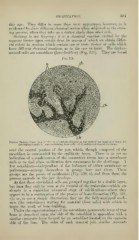Page 571 - My FlipBook
P. 571
OSSIFICA TIOX. 581
this age. They differ in more than mere appearance, however, as is
evidenced by their different chemical action when .subjected to the stain-
ing process, when they take on a darker shade than other cells.
tStainiuf/ is not tiiKjeiiu/ ; it is a chemical reaction exerted by the
separate tissues upon certain dyes, by reason of which we obtain differ-
ent colors in sections which contain one or more tissues or cells which
have different chemical reactions, as in the case in hand. The darker-
stained cells are osteoblasts {bone-builders) (Fig. 321). They are found
Fig. 321.
Porciue Embryo {n cm. long X 2.50) : a, osteoblasts situated at the ends of the lamellse of bone; (^6,
developing lamella of bone containing bone-cells; cl, cl, embryonal connective tissue.
near the central portion of the jaw, which, though composed of the
mesoblast, is surrounded by the epiblastic layer. .There is as yet no
indication of a condensation of the connective tissue into a membrane
fir.st commences in the skull-cap. A
such as we find when ossification
few osteoblasts—independent of the influence of either membrane or
periosteum—arrange themselves in groups here and there. These
groups are the points of os.sification (Fig. 320, o), and from them the
process extends as the jaAv develops.
At fir.st these specialized cells are grouped together in a double layer,
but later they mav be seen at the termini of the trabeculfe—which are
already in a somewhat advanced stage of calcification—where they
appear to be a continuation of the process of bone-formation (Fig. 321,
o) ; or, to use a simple illu.stration, they are the fully-equipped work-
men (the osteoblasts) waiting for material (lime salt.s) with which to
begin the work of bone-building.
Under the superintendency of the osteoblasts, a crescentic layer of true
bone is deposited upon the side of the osteoblast in appo.^ition with a
similar crescentic laver formed by an osteol)last located on the opposite
side of the line. The sides of each crescent join similar crescents


